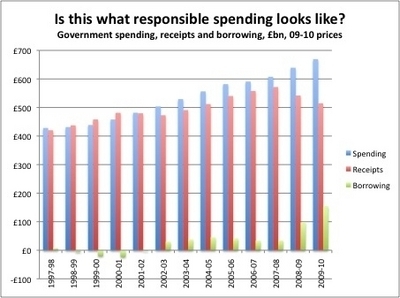Ed Miliband has penned a combative but incredible piece in today’s Times (£). He makes two substantial points. First, that the coalition is deceiving people: Labour was not to blame for the deficit. And second, the coalition’s cuts package (in its entirety) is unnecessary.
Oh what a tangled web he’s weaved. His argument is a maze of conceits, sleights of hand and subterfuge, and he interchanges between debt and deficit at his convenience. But, occasionally, his position is exposed. As this Coffee House graph recalls, Labour built a substantial structural deficit prior to the economic collapse.

Tony Blair acknowledged as much in his memoir:
‘We should also accept that from 2005 onwards Labour was insufficiently vigorous in limiting or eliminating the potential structural deficit. The failure to embrace the Fundamental Savings Review of 2005-6 was, in retrospect, a much bigger error than I ever thought at the time.’
This debt binge funded enormous public sector expansion, which, as Blair concedes, would have been unsustainable even without the global financial crisis. Public sector net debt stood at
£349.2bn in April 97/8; it fell to £307.1bn in April 2001/2; then Brown threw caution to the wind, and the debt grew to £827.2bn by April 2008/9. (Cf. page 22/25)
After the crash, the policy became utterly untenable in the long-term. Following Brown and Darling’s gargantuan stimulus, the IMF found that UK debt as a share of GDP grew from 38 percent in 2007 to 69 percent
by October 2010. Cuts therefore became imperative, and a host of impartial economic bodies (including the IMF, OECD and the World Bank) have endorsed the coalition’s actions.
In fact, the cuts are not as deep as Miliband would have you believe. The Treasury produced this graph (click here for enlarged version) comparing the Darling plan (which Labour was following when it last had a coherent economic policy) in black against Osborne’s plan and the OBR’s forecast. Look who would be cutting deeper in 2010-11.







Comments